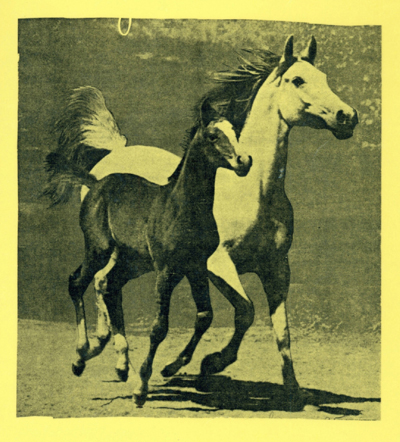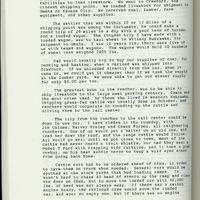058
Item
-
Title
-
058
-
Transcription
-
We were only about five miles from a center where rail cars could be unloaded. The closest loading point was Horn, a siding three miles from the ranch, but it did not have facilities to load livestock. We went to Crawford, the closest shipping point. We loaded livestock for shipment to Omaha or Kansas City. We received coal, lumber, farm equipment, and other supplies.
The settler that was within 10 or 12 miles of a shipping point was among the fortunate, he could make a round trip of 24 miles in a day with a good team of horses, and a loaded wagon. The longest trip I have made with a loaded wagon, was to haul wheat to Whitney Nebraska, for shipment to Omaha. I was 12 years old, there were five of us with teams and wagons. The wagons would hold 40 bushels of wheat that weighed 2400 [sic] lbs.
Dad would usually try to buy our supplies of coal, for cooking and heating, when a carload was shipped into Crawford. If we unloaded directly from the car, when it came in, we could get it cheaper than if we took the supply at the lumber yard. We were able to get our winter supply for only $4.00 per ton.
The greatest boon to the rancher, was to be able to ship livestock to the large meat packing centers. Omaha was the most often used by those who lived in Western Nebraska. Shipping grass-fed cattle was usually done in October, and ranchers would cooperate in rounding up the cattle and driving them to the rail center.
The trip from the ranches to the rail center could be done in one day. I have ridden in the roundup, with Jim Calame, Harvey Finley and Dawes Forbes, all neighboring ranchers. One of us would put a halter on an old cow, and lead her down the road, and the range cattle would follow. All would go well until we got close to town, most of the cattle had never heard a train whistle, nor had they seen a Model T Ford with flapping side curtains, and it took a good cowboy, on his best saddle horse to keep a wild eyed steer from going back home.
Cattle cars had to be ordered ahead of time, in order to have them on track when needed. Several cars would be spotted at the stock yards that had loading ramps. It wasn't hard to chase 40 head of steers up the ramp and close the door on them, but to move the loaded car with 40,000 lbs. of beef was not always easy. If there was a switch engine handy, the railroad crew would move the loaded car, and spot an empty one, but if there was no engine
-
Rights
-
To inquire about usage, please contact Archives & Special Collections, University of Nebraska-Lincoln Libraries. These images are for educational use only. Not all images are available for publication.
 Metzger Memories
Metzger Memories


